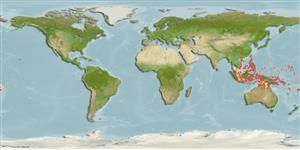>
Gobiiformes (Gobies) >
Gobiidae (Gobies) > Gobiinae
Etymology: Trimma: Greek, trimma, -atos = something crushed (Ref. 45335); cana: Specific epithet is an arbitrary combination of letters embodying the first three letters of both the English words 'candy' and 'cane'; an allusion to adding red bands to a white candy formed in the shape of a shepherd's crook. An noun in apposition..
More on author: Winterbottom.
Environment: milieu / climate zone / depth range / distribution range
Écologie
marin démersal; profondeur 12 - 35 m (Ref. 90102). Tropical
Western Pacific: Philippines, Caroline Is., Fiji, Marshall Is., and Palau
Taille / Poids / Âge
Maturity: Lm ? range ? - ? cm
Max length : 2.5 cm SL mâle / non sexé; (Ref. 52975)
Épines dorsales (Total): 7; Rayons mous dorsaux (Total): 9-10; Épines anales 1; Rayons mous anaux: 8 - 10. Diagnosis: White background with 8 distinct vertical bars on head and body; yellow spots on the medial fins; a well-defined dark bar across the postorbital region of the skull (may be partially obscured by the overlying anterior extension of the epaxialis body musculature in larger specimens). No scales on head. Opercle, cheek, or nape. A second dorsal spine varying from slightly to very elongate (as far as the mid-peduncle). A well-developed interorbital trench. A variably-developed postorbital trench (usually developed). A fifth pelvic fin ray which is unbranched and 50-85% of the fourth.
Solitary or in small groups on surface of hard corals. Inhabits steep outer reef slopes in 12-35 m (Ref. 90102).
Life cycle and mating behavior
Maturité | Reproduction | Frai | Œufs | Fécondité | Larves
Winterbottom, R., 2004. Three new species of Trimma (Pisces: Gobiidae) from the central, western and south Pacific. aqua, J. Ichthyol. Aquat. Biol. 9(1):7-16. (Ref. 52975)
Statut dans la liste rouge de l'IUCN (Ref. 130435)
Menace pour l'homme
Harmless
Utilisations par l'homme
Plus d'informations
Noms communsSynonymesMétabolismePrédateursÉcotoxicologieReproductionMaturitéFraiRassemblement de ponteFéconditéŒufsDéveloppement de l'œuf
RéférencesAquacultureProfil d'aquacultureSouchesGénétiqueElectrophoresesHéritabilitéPathologiesTraitementNutrientsMass conversion
CollaborateursImagesStamps, Coins Misc.SonsCiguateraVitesseType de nageSurface branchialeOtolithesCerveauxVision
Outils
Articles particuliers
Télécharger en XML
Sources Internet
Estimates based on models
Preferred temperature (Ref.
123201): 26.3 - 29, mean 28 °C (based on 102 cells).
Phylogenetic diversity index (Ref.
82804): PD
50 = 0.5000 [Uniqueness, from 0.5 = low to 2.0 = high].
Bayesian length-weight: a=0.01023 (0.00477 - 0.02194), b=3.02 (2.84 - 3.20), in cm total length, based on LWR estimates for this (Sub)family-body shape (Ref.
93245).
Résilience (Ref.
120179): Haut, temps minimum de doublement de population inférieur à 15 mois (Preliminary K or Fecundity.).
Fishing Vulnerability (Ref.
59153): Low vulnerability (10 of 100).
Nutrients (Ref.
124155): Calcium = 1050 [421, 3,702] mg/100g; Iron = 3.08 [1.49, 7.03] mg/100g; Protein = 17.4 [15.3, 19.1] %; Omega3 = 0.285 [0.093, 0.794] g/100g; Selenium = 47.7 [15.7, 125.5] μg/100g; VitaminA = 32.2 [7.5, 129.8] μg/100g; Zinc = 4.04 [2.34, 6.73] mg/100g (wet weight);
